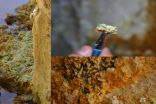(Press-News.org) An international team of physicists has calculated the efficiency of a reaction involving an incoming electron kicking out an electron from the metal beryllium (Be) or its hydrogen compound molecules, in an article about to be published in EPJ D. The efficiency, which partly depends on the electron's incoming speed, is encapsulated in a quantity referred to as electron-impact ionisation cross sections (EICS). Electron-molecule interactions matter because they occur in a broad range of applications from the simplest like fluorescent lamps to the most complex, for example, in ionised matter found in plasmas such as latest generation screens, the outer space of the universe, and in fusion reactors.
In the future fusion reactor prototype ITER, currently being built in southern France, beryllium comes into the plasma because it is one of the constituent materials of the fusion chamber walls. The walls get eroded on contact with hot hydrogen plasma leading to the formation of beryllium in gaseous form and beryllium hydrides, BeH and BeH2, present in various forms of electric charge and state.
Given this intrusion of beryllium in the hydrogen plasma, fusion requires a knowledge of the EICS to predict and simulate its operations. The problem is that EICS are very difficult to calculate exactly. Instead, the authors relied on two approximation methods namely, the Deutsch–Märk (DM) and the Binary-Encounter-Bethe (BEB) method. These methods, albeit not new, have never before been applied to beryllium and its derivatives.
To use these models, the authors first collected the necessary input data obtained from quantum chemical calculations of characteristics such as orbital energies, kinetic energies and orbital populations. To facilitate use of their EICS by the ITER team, the authors eventually converted the numerical cross sections into equations used in simulation codes.
###
Reference:
T. Maihom, I. Sukuba, R. Janev, K. Becker, T. Märk, A. Kaiser, J. Limtrakul, J. Urban, P. Mach and M. Probst (2013), Electron Impact Ionization Cross Sections of Beryllium and Beryllium Hydrides, European Physical Journal D, DOI 10.1140/epjd/e2012-30691-1
For more information, please visit www.epj.org
The full-text article is available to journalists on request.
Fusion helped by collision science
Understanding the mechanisms of electron-molecule collisions could help predict the operations inside the fusion chamber of the ITER reactor
2013-01-11
ELSE PRESS RELEASES FROM THIS DATE:
Protein recognition and disorder: A debate
2013-01-11
The extent to which three-dimensional structure is required for protein recognition and function is an area of vigorous debate with clear implications for protein engineering. Two differing viewpoints have been put forward in two articles published in F1000 Biology Reports today.
In structuring their arguments, the authors were encouraged to consider the opposing viewpoint, examine the points put forward and critique them in their own articles. This novel collaborative approach has given rise to a considered exchange of ideas and may consequently stimulate further research ...
The saline hiding places for bacteria in Río Tinto could be like those on Mars
2013-01-11
Researchers at the Centre of Astrobiology have identified microorganisms that live inside salt deposits in the acidic and ferrous environment of the Tinto River in Huelva, Spain. The extreme conditions of these microniches appear to be similar to those of the salt deposits on Mars and Jupiter's moon, Europa. This possibility should be borne in mind on missions operating in these places, such as Curiosity.
The high doses of radiation, lack of moisture and extreme temperature and pressure on the surface of Mars make the development of life difficult. Within this hostile ...
New treatment could combat deadly chemical agents
2013-01-11
An enzyme treatment which could neutralise the effects of lethal chemicals responsible for the deaths of hundreds of thousands of people across the world has been developed by experts at the University of Sheffield.
Organophosphorus agents (OP) are used as pesticides in developing countries and acute poisoning is common because of insufficient control, poor storage, ready availability, and inadequate education amongst farmers.
It is estimated about 200,000 people die each year across the world from OP poisoning, through occupational exposure, unintentional use and misuse, ...
UGA discovery promises to improve drugs used to fight cancer, other diseases
2013-01-11
Athens, Ga. – Even when at rest, the human body is a flurry of activity. Like a microscopic metropolis locked in a state of perpetual rush hour traffic, the trillions of cells that make us who we are work feverishly policing the streets, making repairs, building new structures and delivering important cargo throughout the bustling organic society.
For everything to work properly there must be something to organize and direct the various workers. Enter protein kinases. Like specialized traffic signals, this huge class of proteins is critical for many aspects of cell communication, ...
Researchers use iPSCs to define optimal treatment for managing life-threatening arrhythmias
2013-01-11
Researchers used induced pluripotent stem cells (iPSCs) derived from a young patient with Long QT syndrome (LQTS), a congenital heart disorder, to determine a course of treatment that helped manage the patient's life-threatening arrhythmias. The results, which appear in The Journal of General Physiology, could lead to improved treatments for LQTS and other channelopathies, diseases caused by disturbed ion channel function.
iPSCs—adult cells that have been genetically reprogrammed to function like embryonic stem cells—provide a valuable tool for studying diseases and ...
Clamorous city blackbirds
2013-01-11
This press release is available in German.
Animals have developed a variety of strategies for dealing with increasing noise pollution in their habitats. It is known, for example, that many urban birds sing at a high pitch to differentiate their song from the low-frequency sound of road traffic. However, as scientists from the Max Planck Institute for Ornithology discovered, this is just a useful side effect. The real reason for this behaviour is that songs at a higher pitch are also automatically louder. The birds can make themselves heard far better in city noise ...
Lady beetle diet influences its effectiveness as biocontrol agent
2013-01-11
This press release is available in Spanish.
By examining what lady beetles eat, U.S. Department of Agriculture (USDA) scientists are learning more about the movement of these beneficial insects in farm fields—and whether they'll actively feed on crop pests.
Agricultural Research Service (ARS) entomologist Jonathan Lundgren at the North Central Agricultural Research Laboratory in Brookings, S.D., and former ARS entomologist Michael Seagraves were part of a team of ARS and university scientists that examined how a lady beetle's diet alters its feeding patterns and ...
Nearby dwarf galaxy and possible protogalaxy discovered
2013-01-11
Peering deep into the dim edges of a distorted pinwheel galaxy in the constellation Ursa Major (the Great Bear), astronomers at Case Western Reserve University and their colleagues have discovered a faint dwarf galaxy and another possible young dwarf caught before it had a chance to form any stars.
Within the faint trails of intergalactic traffic, the researchers also found more evidence pointing to two already known dwarf galaxies as probable forces that pulled the pinwheel-shaped disk galaxy known as M101 out of shape.
M101 is the dominant member in a group of 15 ...
Game-based economics research explains why we roll the dice on flu shots
2013-01-11
With 41 states having reported widespread and severe outbreaks of flu this season, timely new research sheds light on why less than half of the American population has gotten a flu shot.
Despite widespread knowledge that a vaccine is the best way to reduce the chances of catching and spreading the flu, even three of the four main TODAY show anchors recently admitted they had not gotten a flu shot (until they did so live on the air).
Using an online computer game that simulates the spread of an infectious disease among its players, researchers at Wake Forest University ...
Experts aim to redefine healthcare and research ethics
2013-01-11
In what they acknowledge as a seismic shift in the ethical foundation of medical research, practice and policy, a prominent group of interdisciplinary healthcare experts, led by bioethicists at Johns Hopkins, rejects an ethical paradigm that has guided the American system since the 1970s and calls for morally obligatory participation in a "learning healthcare system" more in step with the digital age. The group has authored a pair of articles outlining their arguments and proposal for a new ethical framework, which appear in a special report from The Hastings Center Report, ...
LAST 30 PRESS RELEASES:
Membrane magic: FAMU-FSU researchers repurpose fuel cells membranes for new applications
UN Member States pledge to increase access to diagnosis and inhaled medicines for the 480 million people living with COPD
Combination therapy shows potential to treat pediatric brain cancer ATRT
Study links seabird nesting to shark turf wars in Hawai‘i
Legal sports betting linked to sharp increases in violent crime, study finds
Breakthrough AI from NYUAD speeds up discovery of life-supporting microbes
New Eva Mayr-Stihl Foundation funding initiative boosts research at University of Freiburg on adaptation of forests to global change
The perfect plastic? Plant-based, fully saltwater degradable, zero microplastics
Bias in data may be blocking AI’s potential to combat antibiotic resistance
Article-level metrics would provide more recognition to most researchers than journal-level metrics
Satiety’s little helper: Protein that supports appetite regulating protein identified
UF dives deep into predicting storm damage with computer models
A stormy ocean voyage yields insights on the global carbon cycle
Scientists identify first non-coding gene that controls cell size
Demonstration of altermagnetism in RuO₂ thin films -- A new magnetic material for the AI era
Penn researchers awarded $25M to conduct trial using smartphones to fight heart disease
PCORI awards funding for new patient-centered healthcare research
Exploring the origins of the universe: 145 low-noise amplifiers complete ALMA telescopes
Empress cicada wings help illuminate molecular structure
Using sound waves to detect helium
Time burden in patients with metastatic breast and ovarian cancer from clinic and home demands
Researchers discover bias in AI models that analyze pathology samples
Scientists ID potential way to prevent brain injuries from triggering Alzheimer's
MASTER 2nd Open Call: Execution period kick-off
Algae for health in food and pharma
Advanced microrobots driven by acoustic and magnetic fields for biomedical applications
Chicago health information leader recognized for raising CPR readiness and blood pressure awareness
The Intimate Animal, a new book from Kinsey Institute Executive Director Dr. Justin Garcia
When blue-collar workers lose union protection, they try self-employment
New video dataset to advance AI for health care
[Press-News.org] Fusion helped by collision scienceUnderstanding the mechanisms of electron-molecule collisions could help predict the operations inside the fusion chamber of the ITER reactor


